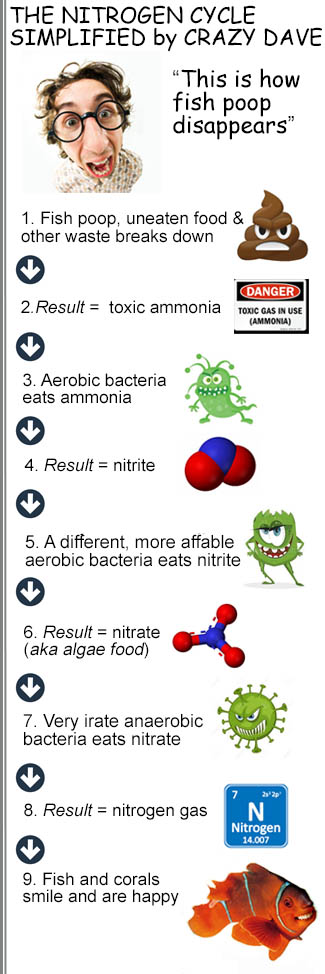What is Aquarium
Biological Filtration?

Biological filtration is the most important kind of filtration in your aquarium. What exactly is biological filtration? How does it work? How do you use it?
What is Biological Filtration?
Uneaten fish food, fish excretions and dead
plant, fish and coral debris accumulate in aquariums. These materials are unattractive and they
develop into dissolved toxins such as ammonia and nitrate. Ammonia and
nitrate will kill fish and corals.
Biological filtration in aquariums is the natural process that converts unwanted materials into non-harmful materials and gasses. This process is commonly called the nitrogen cycle.
How Does Biological Filtration Work?
Unwanted material most often enters the aquarium when you feed your fish. Some fish food is uneaten and some is eaten and excreted by fish. Uneaten food and fish excretions decay into toxic compounds that can poison your aquarium inhabitants.
Biological filtration can start with scavenging animals (
e. g. shrimp, snails, crabs) that eat uneaten food and fish waste. Keep in mind these scavenger animals will also excrete waste that will also dissolve into toxic ammonia and phosphorous, but the amount will be lessened.
Aerobic bacteria consume ammonia and turn it into nitrite, and then more aerobic bacteria consume the nitrite and turn it into nitrate. Aerobic bacteria are bacteria that live in highly oxygenated areas.
After the nitrite is converted to nitrate, anaerobic bacteria consumes the nitrate in conjunction with phosphorous and carbon to convert the nitrate into nitrogen gas. Nitrogen gas leaves the aquarium and reenters the atmosphere. Anaerobic bacteria live in low oxygen areas.
While ammonia, nitrite, nitrate are harmful to fish and corals, they are needed for freshwater plant growth. Ammonia, nitrite, nitrate and phosphorous are fertilizer for algae and plants.
How to Use Biological Filtration?
As mentioned in the previous section, using bacteria, scavenger animals, algae and plants (freshwater) can all be part of a biological filtration plan.
Utilizing Bacteria
Natural Bacteria
Biological filtration utilizing bacteria will happen no matter what you do. Bacteria exists everywhere. Itís in the air, in the water and everywhere else. It will live in the sand, rocks and on the glass of any aquarium.
The trick with an aquarium is to create as much surface area as possible. The more surface area, the more bacteria. The simplest way to do this is to use bio media or a bio grid. This media often comes with canister filters and power filters, and can usually be added to a canister filter or sump. This media is called bio balls, bio media, bio rings or ceramic rings. For even more surface area you could use an advanced biomedia such as
Brightwell Aquatics Xport Bio Bricks.
Jump Starting Bacteria
Although you will probably eventually have sufficient bacteria with standard bio medias, when you are starting a new tank the accumulated bacteria may be inadequate. We recommend using
Brightwell Aquatics MicroBacter7 250 ml with new tanks.
Carbon Dosing
Carbon dosing is a way to turbo charge the anaerobic bacteria that remove nitrate and phosphate. Carbon dosing can be done using
NPX Bioplastics in a reactor.
Further reading:
Organic Carbon Dosing Article
Utilizing Algae & Plants
Saltwater
In saltwater aquariums, algae such as calurpa or chaeto will help biological filtration because the algae will use the toxic waste as a fertilizer. Because algae is considered unattractive it is usually grown in a refugium (the name refers to its original use as a refuge for organisms that canít survive in the main aquarium). We carry the the
CPR Aquatic Refugiums and
FijiCube Refugiums.
Further reading:
Refugium Overview Article
Freshwater
Ammonia, nitrite, nitrate and phosphorous are all excellent plant fertilizers. The more plants, the better.
Utilizing Scavengers
It is important to include a clean up crew in your aquarium. A clean up crew consists of the scavenging animals that eat uneaten food and fish waste. In freshwater aquariums adding loaches, shrimp, snails and cory cat fish will help. In saltwater adding snails, crabs, shrimp, brittle starfish, and sand sifting gobies will help.
The Relationship Between Biological Filtration & Mechanical Filtration
The more often you replace your mechanical filter media, the less waste you will have in your system that will have to be removed by biological filtration
. In reef aquariums, removing waste is best done by protein skimmers.




























 Biological filtration is the most important kind of filtration in your aquarium. What exactly is biological filtration? How does it work? How do you use it?
Biological filtration is the most important kind of filtration in your aquarium. What exactly is biological filtration? How does it work? How do you use it?